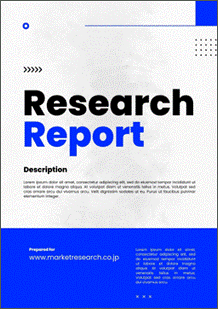 | • レポートコード:MRC2304G021 • 出版社/出版日:Mordor Intelligence / 2023年2月 • レポート形態:英文、PDF、100ページ • 納品方法:Eメール(受注後2-3営業日) • 産業分類:食品 |
| Single User | ¥703,000 (USD4,750) | ▷ お問い合わせ |
| Corporate License | ¥1,295,000 (USD8,750) | ▷ お問い合わせ |
• お支払方法:銀行振込(納品後、ご請求書送付)
レポート概要
| Mordor Intelligence社の市場調査レポートによると、世界の食品アミノ酸市場規模が予測期間中(2022年-2027年)にCAGR 6.23%拡大すると見られています。本レポートでは、食品アミノ酸の世界市場を調査対象とし、イントロダクション、調査手法、エグゼクティブサマリー、市場動向、種類別(グルタミン酸、リジン、トリプトファン、メチオニン、その他)分析、用途別(ダイエットサプリメント、栄養強化食品・飲料、乳児栄養)分析、地域別(アメリカ、カナダ、メキシコ、イギリス、ドイツ、フランス、ロシア、イタリア、スペイン、インド、中国、日本、オーストラリア、ブラジル、アルゼンチン、サウジアラビア、南アフリカ)分析、競争状況、市場機会・将来動向、新型コロナウイルス感染症の影響などを整理しました。並びに、市場調査の対象企業には、Prinova Group LLC、Ajinomoto Co. Inc.、Merck KGaA、Daesang Corporation、Evonik Industries AG、Brenntag AG、Kyowa Hakko Bio Co. Ltd、Koninklijke DSM NV、Kemin Industries、AMINO GmbHなどが含まれています。 ・イントロダクション ・調査手法 ・エグゼクティブサマリー ・市場動向 ・世界の食品アミノ酸市場規模:種類別 - グルタミン酸の市場規模 - リジンの市場規模 - トリプトファンの市場規模 - メチオニンの市場規模 - その他食品アミノ酸の市場規模 ・世界の食品アミノ酸市場規模:用途別 - ダイエットサプリメントにおける市場規模 - 栄養強化食品・飲料における市場規模 - 乳児栄養における市場規模 ・世界の食品アミノ酸市場規模:地域別 - 北米の食品アミノ酸市場規模 アメリカの食品アミノ酸市場規模 カナダの食品アミノ酸市場規模 メキシコの食品アミノ酸市場規模 … - ヨーロッパの食品アミノ酸市場規模 イギリスの食品アミノ酸市場規模 ドイツの食品アミノ酸市場規模 フランスの食品アミノ酸市場規模 … - アジア太平洋の食品アミノ酸市場規模 インドの食品アミノ酸市場規模 中国の食品アミノ酸市場規模 日本の食品アミノ酸市場規模 … - 南米/中東の食品アミノ酸市場規模 ブラジルの食品アミノ酸市場規模 アルゼンチンの食品アミノ酸市場規模 サウジアラビアの食品アミノ酸市場規模 … ・競争状況 ・市場機会・将来動向 ・新型コロナウイルス感染症の影響 |
The food amino acids market is projected to register a CAGR of 6.23% during the forecast period 2022-2027.
During the COVID-19 pandemic, the demand for functional food increased, resulting in increased demand for food amino acids. The intake of dietary supplements and fortified food and beverage led to the escalating demand for amino acids. Moreover, some particular types of amino acids, like tryptophan, were deemed essential for consumption. This sleep-inducing amino acid also enhances immunity, which became extremely important during the pandemic.
The increasing demand for amino acids as functional foods, coupled with the rising adoption of glutamic acid as a flavor enhancer in various foods and beverages, is likely to propel the market’s growth over the next few years. The wide range of applications of amino acids, ranging from flavor development and preservation to acting as a nutritional component or building block of protein to specialty ingredients, such as aspartame, is expected to drive the market.
Additionally, the increase in demand for amino acids for various nutraceutical and dietary supplements, owing to the health benefits offered by amino acids, is expected to fuel the demand for amino acids during the forecast period. The use of lysine in dietary supplements is expected to boost the market’s growth as well.
Food Amino Acids Market Trends
Increasing Demand for Functional Food and Beverage
The rise in demand for food amino acids is due to the significant increase in demand for functional food and beverages. Protein remains in the top position among functional food, and amino acids are known to be building blocks of protein formation. Amino acids have been found to have multiple functional benefits in human nutrition. For example, glycine improves sleep quality, and leucine plays a significant role in muscle protein synthesis, thus, contributing to longer and healthy life expectancy among the elderly population. Ingredient manufacturers are now focusing on creating food amino acid ingredients that can be used in creating functional food and beverage, thereby enhancing their nutritional properties. For instance, in 2021, Arla Foods Ingredients launched a whey protein ingredient containing essential amino acids, targeting the South American yogurt market. This ingredient can increase the protein content in the product more than the general amount, making it functionally healthier for consumption.
Asia-Pacific Holds the Major Market Share
The Asia-Pacific region holds the largest market share, followed by North America. The increase in the use of food amino acids as a flavor enhancer in the food industry and the growth in concern for a healthy diet among consumers is fuelling the demand for food amino acids in the Asia-Pacific market. Major demand for food amino acids from the dietary supplement industry has been seen due to the growing trend of adding dietary supplements to consumer diets in this region. The major importers of food amino acids include China and Indonesia, among others, in the Asia-Pacific region. Owing to the increasing consumption of processed and convenience food, the import and export in developing countries are growing steadily. The rapid growth in demand for food amino acids in Southeast Asia’s malnourished and deprived population is further boosting the market’s growth in this region.
Food Amino Acids Market Competitor Analysis
The global food amino acids market is fragmented owing to the presence of many players in the market. It consists of international players and local manufacturers at different levels of the value chain. Some of the major players in the market are Prinova Group LLC, Kemin Industries, Daesang Corporation, Evonic Industries AG, and Ajinomoto Co. Inc., among others. These companies are focused on providing differentiated products to customers. The food amino acid ingredient suppliers are extending their product line to diversify their presence geographically by collaborating with other players in the market. Product innovation is a key strategy to gain a significant share in the food amino acids market.
Additional Benefits:
- The market estimate (ME) sheet in Excel format
- 3 months of analyst support
1 INTRODUCTION
1.1 Study Assumptions and Market Definition
1.2 Scope of the Study
2 RESEARCH METHODOLOGY
3 EXECUTIVE SUMMARY
4 MARKET DYNAMICS
4.1 Market Drivers
4.2 Market Restraints
4.3 Porter’s Five Forces Analysis
4.3.1 Threat of New Entrants
4.3.2 Bargaining Power of Buyers/Consumers
4.3.3 Bargaining Power of Suppliers
4.3.4 Threat of Substitute Products
4.3.5 Intensity of Competitive Rivalry
5 MARKET SEGMENTATION
5.1 By Type
5.1.1 Glutamic Acid
5.1.2 Lysine
5.1.3 Tryptophan
5.1.4 Methionine
5.1.5 Phenylalanine
5.1.6 Other Types
5.2 By Application
5.2.1 Dietary Supplements
5.2.2 Fortified Food and Beverage
5.2.3 Infant Nutrition
5.3 Geography
5.3.1 North America
5.3.1.1 United States
5.3.1.2 Canada
5.3.1.3 Mexico
5.3.1.4 Rest of North America
5.3.2 Europe
5.3.2.1 United Kingdom
5.3.2.2 Germany
5.3.2.3 France
5.3.2.4 Russia
5.3.2.5 Italy
5.3.2.6 Spain
5.3.2.7 Rest of Europe
5.3.3 Asia-Pacific
5.3.3.1 India
5.3.3.2 China
5.3.3.3 Japan
5.3.3.4 Australia
5.3.3.5 Rest of Asia-Pacific
5.3.4 South America
5.3.4.1 Brazil
5.3.4.2 Argentina
5.3.4.3 Rest of South America
5.3.5 Middle-East
5.3.5.1 Saudi Arabia
5.3.5.2 South Africa
5.3.5.3 Rest of Middle-East
6 COMPETITIVE LANDSCAPE
6.1 Most Active Companies
6.2 Most Adopted Strategies
6.3 Market Share Analysis
6.4 Company Profiles
6.4.1 Prinova Group LLC
6.4.2 Ajinomoto Co. Inc.
6.4.3 Merck KGaA
6.4.4 Daesang Corporation
6.4.5 Evonik Industries AG
6.4.6 Brenntag AG
6.4.7 Kyowa Hakko Bio Co. Ltd
6.4.8 Koninklijke DSM NV
6.4.9 Kemin Industries
6.4.10 AMINO GmbH
7 MARKET OPPORTUNITIES AND FUTURE TRENDS
8 IMPACT OF COVID-19 ON THE MARKET